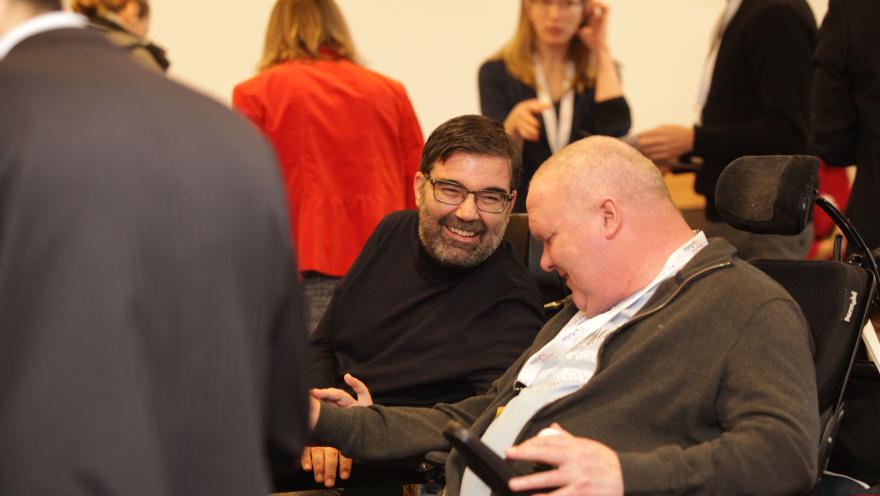After over a year in the making, the ALS Assistive Technology Challenge came to its culmination at the finale event during the ALS/MND International Alliance Meeting in Dublin. All five finalist teams came together to show off their prototypes to our esteemed judging team. The meeting participants living with ALS also had a chance to try out each new technology. Every finalist had an innovative idea – from brain computer interface technology to voice message banking - to help people living with ALS communicate with ease. This is extremely important to their quality of life and why the Challenge was started in the first place. Here is a photo summary of this exciting event, ending with the winners.
Dr. Lucie Bruijn, Chief Scientist of The ALS Association, kicked off the event.
Our esteemed judging panel (starting back left): Jay Beavers, Kevin Caves, Dr. Jane Huggins, Dr. Lucie Bruijn, Bob Koppes, Dr. Maya Bronfeld, Dr. Ammar Al-Chalabi, Bernard Muller (front left) and Shay Rishoni (front right). Even Pat Quinn participated remotely via Skype.
Each team had 10 minutes to explain and demonstrate their new technology to the judges. It was a whirlwind effort to fit in all the technologies’ dynamic features and to answer questions.
The Donders Institiute for Brain, Cognition and Behavior team from the Netherlands led by Dr. Peter Desain explains their barcode-based brain computer interface (BCI), called NoiseTag BCI. “Noisetags” are fast-coded sequences, much like a barcode scanned in time, which correlate to a letter in the alphabet. When a person looks at each NoiseTag on the computer, a letter is typed. Other cool features include the use of dry electrodes, allowing for a comfortable headset without gels and it requires no calibration – just plug and play. NoiseTags can also be used beyond the computer to accomplish everyday tasks like opening a door.
The Pison Technology team led by Dexter Ang and David Cipoletta demonstrated their novel wearable sensors based on muscle electromyography (EEG) signals that create a motionless communication and control system. It has multiple functionality, where it provides a real-time look into a person’s nervous system to track muscle strength over time, while giving a person without any mobility the ability to use a laptop, phone and home robotics 24/7. Dexter began this company based out of Massachusetts after his mother was diagnosed with ALS. Kyle Conners believes in their technology so much that he traveled to Dublin to help demonstrate the wearable sensors as a part of the team.
Team Project Vive led by Mary Elizabeth McColloch, CEO, a recent graduate of Penn State University and Rodney Miller, Lead Developer out of Pennsylvania - demonstrated their two-part system consisting of speech generating device and wearable sensors created for people living with ALS with low-motor control. Some of its great features include the ability to speak with your own “true” voice and in multiple languages. The wearable sensors were designed for use on the elbow, foot, hand or knee.
One of the AT Challenge’s Phase I winners, BlueSky Designs led by Dianne Goodwin out of Minneapolis, was also picked as one of the top five finalists. She and Nick Lee designed a powered positioning system that can automatically move an eye gaze-controlled speech device to accommodate a person’s exact head and face orientation. This system can also be used to position other essential equipment near the face, such as a tube for suctioning or a straw for taking a drink.
The other AT Challenge $50,000 Phase I winner, John Costello from Boston Children’s Hospital came with his Program Manager, David Lee to show off their Message Banking system that provides a free and open message bank for people at risk of losing their voice. It allows a person to bank meaningful, emotional and richly personal messages for their loved ones. People can upload recordings in a matter of minutes and easily label and categorize their messages in an organized, stream-lined manner.
After the judging ended, the room was opened up to the public. People living with ALS from Dublin and meeting attendees came in to try out the new technologies and offered advice on how to improve. There was so much hope and enthusiasm in the room.
At the end of the day, each team came away with a participant award. Even if they did not win, each team left with new ideas on how to improve their prototypes and made valuable connections with top ALS scientists and technology experts to help move their technology forward.
After an exciting day filled with enthusiasm, the winners were finally announced. The Donders Institute and Pison Technology teams won the ALS Assistive Technology Challenge! Both teams exhibited unique and innovative technologies and have promising potential for offering life altering communications solutions for people living with ALS.
To read more about the ALS Assistive Technology Challenge, please visit https://www.als.org.
To learn more about assistive technology, please visit https://www.als.org.
Read press release about the winners here.
Learn more about the Pison Technology team with their interview here.


Join the conversation. Please comment below.